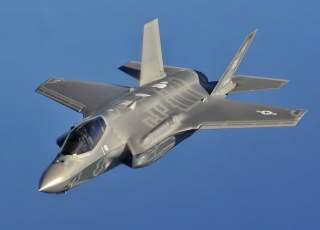America's F-35 Stealth Fighter: The Ultimate Nuclear Bomber?
Adding a nuclear-capable F-35 to the air portion of the nuclear triad – to supplement the existing B-2, B-52 and emerging B-21 – will bring a new dimension to US nuclear attack options
New Bomber:
Regarding the Air component, the Air Force recently completed a critical design review of its new B-21 Raider nuclear-capable stealth bomber. As is often the case with nuclear weapons, many of the details regarding the development of this platform are not available, but there is widespread discussion among US Air Force leaders that the bomber is expected to usher in a new era of stealth technology; much of the discussion focuses upon the bomber’s ability to operate above advanced enemy air defenses and “hold any target at risk anywhere in the world,” the Air Force Military Deputy for Acquisition Lt. Gen. Arnold Bunch has told Warrior Maven in past interviews.
Early available renderings of the bomber show what appears to be an advanced B-2 like design, yet possibly one with a lower heat signature and improved stealth properties. However, service leaders are quick to point out that, given advancements in Russian air defenses, stealth will surge forward as “one arrow in a quiver” of nuclear attack possibilities. This is due to the fact that the most modern air defenses, such as S-400 and the emerging S-500s, are built with faster processing speed, improved digital networking connecting firing and radar nodes and longer-range targeting technology, among other things.
Concurrently, the Air Force is surging forward with a massive B-2 modernization overhaul, involving new digital nuclear weapons capability and the integration of a developing system called the Defensive Management System. This enables the B-2, which Air Force developers acknowledge may indeed be more vulnerable to advanced air defenses than in earlier years when it was first
built, to more quickly recognize locations of enemy air defenses at safer ranges as a means to avoid detection.
New Nuclear-Armed Ballistic Missile Submarine:
Finally, shifting to a program widely regarded as among the most significant across the DoD enterprise, the Navy is already underway with early development of the new nuclear-armed Columbia-Class ballistic missile submarines. Several key current efforts with this, including early “tube and hull” forging of missile tubes, work on a US-UK common missile compartment – and little discussed upgrades to the Trident II D5 nuclear missiles.
Undersea strategic deterrence, as described by Navy and Pentagon leaders, offers a critical means to ensure a second strike ability in the event of a catastrophic first-strike nuclear attack impacting or disabling other elements of the triad.
While it may seem obvious, nuclear deterrence hinges upon a recognizable, yet vital contradiction; weapons of seemingly limitless destructive power – are ultimately employed to “keep the peace” – and save lives. Along these lines, Senior Navy and Air Force nuclear weapons developers routinely make the point that – since the advent of nuclear weapons – the world has managed to avoid massive, large-scale major power force on force warfare.
While Pentagon leaders rarely, if ever, offer a window into current nuclear-strike capabilities, it is widely discussed that the current North Korean nuclear threat is leading US military planners to envision the full spectrum of nuclear weapons contingencies. Even further, the US did recently send B-2 bombers to the Asian theater – stationing them in Guam.
This first appeared in Warrior Maven here.

